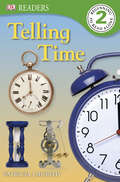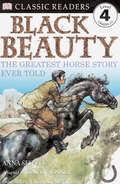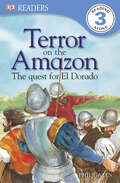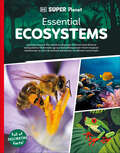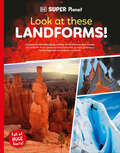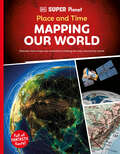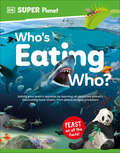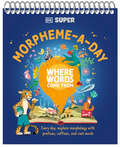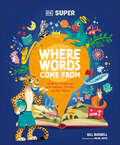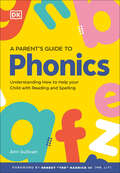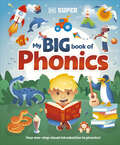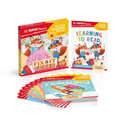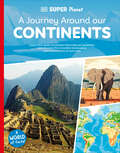- Table View
- List View
DK Readers: Telling Time (DK Readers Level 2)
by Patricia J. MurphyTick, tock. Long ago, people told time using the sun or water. Find out how clocks have changed and become more accurate in this Level 2 DK Reader. Telling Time is a history of timekeeping, from obelisks and sundials to the atomic clocks of today. Packed with full-color photographs, lively illustrations, and engaging, age-appropriate stories to introduce young children to a life-long love of reading. These amazing stories are guaranteed to capture children's interest while developing their reading skills. Perfect for reading together! The playful images in this eBook are enhanced with entertaining animations and surprising sounds to bring this story to life.
DK Readers: Telling Time (DK Readers Level 2)
by Patricia J. MurphyTick, tock. Long ago, people told time using the sun or water. Find out how clocks have changed and become more accurate in this Level 2 DK Reader. Telling Time is a history of timekeeping, from obelisks and sundials to the atomic clocks of today. Packed with full-color photographs, lively illustrations, and engaging, age-appropriate stories to introduce young children to a life-long love of reading. These amazing stories are guaranteed to capture children's interest while developing their reading skills. Perfect for reading together!
DK Readers: The Greatest Horse Story Ever Told (DK Readers Level 4)
by Anna SewellTravel with Black Beauty as he overcomes the harsh life of a carriage horse to rejoin his beloved owners in this retelling of the Anna Sewell classic. Follow Black Beauty's remarkable story and discover what a horse's life was like in Victorian times in this Level 4 DK Reader. Packed with full-color photographs, lively illustrations, and engaging, age-appropriate stories to introduce young children to a life-long love of reading. These amazing stories are guaranteed to capture children's interest while developing their reading skills. Perfect for reading together!
DK Readers: The Greatest Horse Story Ever Told (DK Readers Level 4)
by Anna SewellTravel with Black Beauty as he overcomes the harsh life of a carriage horse to rejoin his beloved owners in this retelling of the Anna Sewell classic. Follow Black Beauty's remarkable story and discover what a horse's life was like in Victorian times in this Level 4 DK Reader. Packed with full-color photographs, lively illustrations, and engaging, age-appropriate stories to introduce young children to a life-long love of reading. These amazing stories are guaranteed to capture children's interest while developing their reading skills. Perfect for reading together! The playful images in this eBook are enhanced with entertaining animations and surprising sounds to bring this story to life.
DK Readers: The Little Ballerina (DK Readers Level 2)
by Sally GrindleyIt's the day of the big show at Laura's ballet school. Suddenly, disaster strikes! Can Laura help save the show?Stunning photographs combine with lively illustrations and engaging, age-appropriate stories in DK Readers, a multilevel reading program guaranteed to capture children's interest while developing their reading skills and general knowledge. With DK Readers, children will learn to read—then read to learn!
DK Readers: The Little Ballerina (DK Readers Level 2)
by Sally GrindleyIt's the day of the big show at Laura's ballet school. Suddenly, disaster strikes! Can Laura help save the show?Stunning photographs combine with lively illustrations and engaging, age-appropriate stories in DK Readers, a multilevel reading program guaranteed to capture children's interest while developing their reading skills and general knowledge. With DK Readers, children will learn to read—then read to learn!
DK Readers: The Quest For El Dorado (DK Readers Level 3)
by DKDeep in the Amazon rainforest Spanish soldiers went looking for El Dorado in the City of Gold. But few survived to tell the tale... Packed with full-color photographs, lively illustrations, and engaging, age-appropriate stories to introduce young children to a life-long love of reading. These amazing stories are guaranteed to capture children's interest while developing their reading skills. Perfect for reading together!
DK Readers: The Quest For El Dorado (DK Readers Level 3)
by DKDeep in the Amazon rainforest Spanish soldiers went looking for El Dorado in the City of Gold. But few survived to tell the tale... Packed with full-color photographs, lively illustrations, and engaging, age-appropriate stories to introduce young children to a life-long love of reading. These amazing stories are guaranteed to capture children's interest while developing their reading skills. Perfect for reading together! The playful images in this eBook are enhanced with entertaining animations and surprising sounds to bring this story to life.
DK Readers: The Story of Chocolate (DK Readers Level 3)
by C.J. PolinA mouthwatering book about chocolate for advanced young readers. Includes gorgeous photography and a full glossary. Full of deliciously tempting facts about everyone's favorite candy.Did you know that the average person eats 100 chocolate bars a year? Or that the largest chocolate confection ever made weighed as much as 140,000 chocolate bars? This history of chocolate fulfills cravings for knowledge by helping children to develop reading skills and a general curiosity about the world around them.Stunning photographs combine with lively illustrations and engaging, age-appropriate stories in DK Readers, a multilevel reading program guaranteed to capture children's interest while developing their reading skills and general knowledge.With DK Readers, children will learn to read—then read to learn!
DK Readers: The Story of Chocolate (DK Readers Level 3)
by C.J. PolinA mouthwatering book about chocolate for advanced young readers. Includes gorgeous photography and a full glossary. Full of deliciously tempting facts about everyone's favorite candy.Did you know that the average person eats 100 chocolate bars a year? Or that the largest chocolate confection ever made weighed as much as 140,000 chocolate bars? This history of chocolate fulfills cravings for knowledge by helping children to develop reading skills and a general curiosity about the world around them.Stunning photographs combine with lively illustrations and engaging, age-appropriate stories in DK Readers, a multilevel reading program guaranteed to capture children's interest while developing their reading skills and general knowledge.With DK Readers, children will learn to read—then read to learn!
DK SUPER PLANET Essential Ecosystems (DK Super Planet)
by DKJourney around the world to discover the rich and diverse ecosystems that make up our beautiful planet in this learn-to-read series.DK Super Planet Essential Ecosystems is part of the new DK Super Planet series and encourages children aged 7-11 to explore the fascinating environments on our planet.Captivating and curriculum-aligned, this book is the perfect support for learning about the wonders of our planet. It covers core scientific content, including tropical rainforests, hot and cold deserts, and savannas.This learn-to-read book for children offers:A guide to reading through curriculum-aligned content and exciting illustrations.A highly visual approach that makes the association between words and where they originate easier to understand.Material to help children become more confident readers, speakers, and spellers. Transform learning into an adventure with DK Super Planet, bringing science to life on every page. Engaging content, diagrams, and hands-on experiments provide an immersive learning experience while covering core information about why maps are an important tool. With specially designed sections that build scientific vocabulary and make complex concepts accessible to children, Essential Ecosystems is the ideal companion to any science learning.
DK SUPER PLANET Global Gardens (DK Super Planet)
by DKGrow your knowledge of our world by exploring these glorious green spaces, from hot desert oases to icy Antarctic gardens.DK Super Planet Global Gardens is part of the new DK Super Planet series and children aged 5-7 to explore the fascinating environments on our planet and the animals that live in them.Captivating and curriculum-aligned, this book is the perfect support for learning about the wonders of our planet. It builds background knowledge and covers core scientific content, including ecosystems, the continents, and the different habitats that plants and animals live in.This science book for children offers:A guide to reading through curriculum-aligned content and exciting illustrations.A highly visual approach that makes the association between words and where they originate easier to understand.Material to help children become more confident readers, speakers, and spellers.Captivating and curriculum-aligned content, diagrams and hands-on experiments provide an immersive learning experience while covering core information about a range of ecosystems.With specially designed sections that build scientific vocabulary and make complex concepts accessible to children, Global Gardens is the ideal companion to any science learning. Transform learning into an adventure with DK Super Planet, bringing science to life on every page.
DK SUPER PLANET Look at These Landforms! (DK Super Planet)
by DKExplore the breathtaking variety of landforms that shape our planet—from deep ocean trenches to vast plateaus and the highest mountains on Earth!DK Super Planet Look at these Landforms! Is part of the new DK Super Planet series and encourages young minds to delve into the wonders of our planet.Aligned with science and earth science curricula, this title is part of the dynamic new DK Super Planet series which invites young minds to delve into the mysteries of our planet and beyond. It covers key content, including how fossil fuels, volcanoes, and mountains are formed and how natural hazards occur.This space book for children offers:A guide to reading through curriculum-aligned content and exciting illustrations.A highly visual approach that makes the association between words and where they originate easier to understand.Material to help children become more confident readers, speakers, and spellers. Captivating and curriculum-aligned content, diagrams and hands-on experiments provide an immersive learning experience while covering core information about a range of landforms.With specially designed sections that build scientific vocabulary and make complex concepts accessible to children, Look at these Landforms! is the ideal companion to any science learning. Transform learning into an adventure with DK Super Planet, where science comes to life on every page.
DK SUPER PLANET Place and Time: Mapping Our World (DK Super Planet)
by DKDiscover how maps are essential to finding our way around the world in this learn-to-read series.DK Super Planet Place and Time is part of the new DK Super Planet series and encourages children aged 7-11 to delve into the wonders of our planet.Captivating and curriculum-aligned, this book is the perfect support for learning all about maps and how they help us understand the world around us. It covers core scientific content, including how to use maps to locate places and recognize their human and physical characteristics.This learn-to-read book for children offers:A guide to reading through curriculum-aligned content and exciting illustrations.A highly visual approach that makes the association between words and where they originate easier to understand.Material to help children become more confident readers, speakers, and spellers.Transform learning into an adventure with DK Super Planet, bringing science to life on every page. Engaging content, diagrams, and hands-on experiments provide an immersive learning experience while covering core information about why maps are an important tool.With specially designed sections that build scientific vocabulary and make complex concepts accessible to children, Place and Time is the ideal companion to any science learning.
DK SUPER PLANET Who’s Eating Who? (DK Super Planet)
by DKSatisfy your brain's appetite by learning all about the food chain!Aligned with science and earth science curricula, this title is part of the dynamic new DK Super Planet series which invites young minds to delve into the mysteries of our planet and beyond.Captivating and curriculum-aligned, each book in the series features engaging content, infographics, and hands-on experiments, providing an immersive learning experience. Dive into the wonders of Earth and space, with specially designed spreads that build scientific vocabulary, making complex concepts accessible to children.DK Super Planet goes beyond traditional topic books by incorporating interactive elements. Transform learning into an adventure with DK Super Planet, where science comes to life on every page, fostering a love for discovery and understanding.
DK SUPER PLANET Wonderful Waterways (DK Super Planet)
by DKDive in and explore our planet's incredible range of waterways, from rivers and canals to lakes and the great open oceans.DK Super Planet Wonderful Waterways is part of the new DK Super Planet series and encourages children aged 5-7 to explore the fascinating environments on our planet.Captivating and curriculum-aligned, this book is the perfect support for learning about the wonders of our planet. It builds background knowledge and covers core scientific content, including the water cycle, oceans, rivers, and lakes.This science book for children offers:A guide to reading through curriculum-aligned content and exciting illustrations.A highly visual approach that makes the association between words and where they originate easier to understand.Material to help children become more confident readers, speakers, and spellers.Captivating and curriculum-aligned content, diagrams, and hands-on experiments provide an immersive learning experience while covering core information about a range of ecosystems.With specially designed sections that build scientific vocabulary and make complex concepts accessible to children, Wonderful Waterways is the ideal companion to any science learning. Transform learning into an adventure with DK Super Planet, bringing science to life on every page.
DK SUPER Where Words Come From Morpheme-a-Day (DK Super)
by DKDelve into the fascinating world of morphemes, word formation, and discovery with this visual flip book designed for curious young readers.DK Super Where Words Come From Morpheme-a-Day is the fundamental guide for children aged 7-11 who want to learn about morphology and the origins of words. Every day, flip the page and discover a new, beautifully illustrated morpheme. Ideal for front-of-class interventions or small group instruction, this linguistics book breaks down key morphemes and provides activity ideas to build and develop students' knowledge.This morphology book for children offers:A guide to understanding word formation through prefixes, suffixes, and root words.A highly visual approach that makes association between words and where they originate easier to understand.Follows up on learning etymology, prefixes, suffixes, and Latin and Greek roots to enhance children’s decoding, spelling, and vocabulary. Discover over 100 morphemes in this book and improve morphological awareness, a powerful tool in supporting the five pillars of reading. This also includes boosting vocabulary, improving spelling skills and enhancing reading comprehension.Don’t just read words, understand them!More in the seriesIf you enjoyed DK Super Where Words Come From Morpheme-a-Day, then you’ll love the other titles in this linguistic series. Why not try DK Super Where Words Come From to learn more about the origins of words, or the supplementing activity book to put previously learned material into practice?
DK SUPER Where Words Come From: Guide to Morphology with Prefixes, Suffixes, and Root Words (DK Super)
by DKDelve into the fascinating world of morphemes, word formation, and discovery with this visual reference book, designed for curious young readersDK Super Where Words Come From is the ultimate guide for learning more about morphology and the origins of words. Discover amazing facts about the building blocks of language – from prefixes and suffixes to root words and bases.This morphology book for children offers:A guide to understanding word formation through prefixes, suffixes, and root words.A highly visual approach that makes association between words and where they originate easier to understand.Material to help children become more confident readers, speakers, and spellers through learning etymology, prefixes, and suffixes. Discover over 100 morphemes in this book and improve morphological awareness, a powerful tool in supporting the five pillars of reading. This also includes boosting vocabulary, improving spelling skills, and enhancing reading comprehension.Don’t just read words, understand them!
DK Super Phonics A Parent's Guide to Phonics (DK Super Phonics )
by DKHelp your child take their first steps into the world of phonics and reading with this parent's and caregiver’s guide to reading support.A Parents Guide to Phonics is for parents and caregivers who want to learn how to help their child with reading and spelling. It explains how written language is put together, what phonics is, and how reading and spelling are taught using a structured approach.The book is written using accessible, jargon-free language that is easy to follow and understand. It also includes a section on additional educational needs and what adaptations schools might make to enable pupils with additional needs to access phonics teaching.This parent guide to teaching phonics offers: - An easy-to-understand guide to teaching phonics, with jargon-free language that is easy to follow.- An opportunity to boost home learning for parents and caregivers who want to support their children with phonics at home.- A Science of Reading approach, using a structured approach to teaching and understanding phonics. Written for parents and caregivers and those new to supporting children learning to read, A Parent’s Guide to Phonics explains how written language is put together, what phonics is and how reading and spelling are taught using a structured approach.What is phonics?Phonics is a way of teaching children to read by understanding the sounds that individual letters make and blending them to make a word. Children can learn to read using this skill to decode new words. Phonic Books specialzes in decodable, systematic books supporting this structured literacy instruction.
DK Super Phonics My Big Book of Phonics (DK Super Phonics )
by DKMy Big Book of Phonics is a one-stop visual reference book for young children (aged 4-8).Each spread focuses on a target sound. The spread contains a mnemonic and mouth placement photo for pronunciation guidance. which will be set on a beautifully illustrated scene full of words with the target sound for children to point to and sound out. Decodable words are also included in a bank at the bottom of the page for children to blend the sounds, read the words and boost their spelling.The book will also include a sound chart, introductory pages with hints and information on phonics for caregivers, glossary, and an index.All sounds included in curricula for Key Stage 1 will be covered.
DK Super Phonics My First Decodable Stories Deli Dogs
by DKHelp your child learn to read with Deli Dogs, the perfect phonic books for young readers.Specially developed by experts to introduce young children to phonics and support their first steps in learning to read, this series is ideal for early readers. Children will love to read about Dan and Bell, the dog duo in charge of a busy deli!Eight delightful books introduce consonant blends and consonant digraphs in stages, allowing independent reading from the outset. Each book contains a word list for blending practice and a game to enjoy together!Deli Dogs covers the following phonic skills:Book 1: CVCCBook 2: CCVCBook 3: CCVCCBook 4: chBook 5: shBook 6: thBook 7: ck, whBook 8: ng, quA Parents' Guide to Deli Dogs with advice and activity ideas is also included. Give your child a head start in the world of reading and phonics!This beginner reader series offers:A pack of 8 decodable books that each contain a story that covers different consonant blends and consonant digraphsReading material aimed at children aged 4-6A Parents’ Guide to Deli Dogs is also included, with advice and activity ideasWhat is phonics?Phonics is a way of teaching children to read by understanding the sounds that letters make and blending them to make a word. Children can learn to read using this skill to decode new words. More in the seriesThis series of beginning reader books by DK Super Phonics is a friendly and accessible introduction to learning to read. If you’re looking for more early reader books, why not try DK Super Phonics My First Decodable Stories Fix-it Foxes, which provides further practice of these essential phonic skills.
DK Super Phonics My First Decodable Stories Fix-It Foxes (DK Super Phonics )
by DKHelp your child learn to read with Fix-it Foxes, the perfect phonic books for young readers.Specially developed by experts to introduce young children to phonics and support their first steps in learning to read, this series is ideal for early readers. Children will love joining Fizz and Frank, the foxes in charge of the fix-it shop.Eight delightful books introduce consonant blends and consonant digraphs in small stages, allowing independent reading from the outset. Each book contains a word list for blending practice and a game to enjoy together!Fix-it Foxes covers the following phonic skills:Book 1: CVCCBook 2: CCVCBook 3: CCVCCBook 4: chBook 5: shBook 6: thBook 7: ck, whBook8: ng, quA Parents' Guide to Fix-It Foxes with advice and activity ideas is also included. Give your child a head start in the world of reading and phonics!This beginner reader series offers:A pack of 8 decodable books that each contain a story that covers different consonant blends and consonant digraphsReading material aimed at children aged 4-6A Parents’ Guide to Fix-it Foxes is also included, with advice and activity ideasWhat is phonics?Phonics is a way of teaching children to read by understanding the sounds that letters make and blending them to make a word. Children can learn to read using this skill to decode new words. More in the seriesThis series of beginning reader books by DK Super Phonics is a friendly and accessible introduction to learning to read. If you’re looking for more early reader books, why not try DK Super Phonics My First Decodable Stories Deli Dogs, which provides further practice of these essential phonics skills.
DK Super Phonics My First Decodable Stories Haircut Hippos (DK Super Phonics )
by DKLearn to read with Haircut Hippos, the perfect phonic books for beginners!Specially developed to introduce young children to phonics and support their first steps in learning to read. Children will love joining twin hippos, Pat, and Don, as they team up to run their hair salon.Eight delightful books introduce the sounds of the alphabet in small stages allowing independent reading from the outset. Each book contains a word list for blending practice and a game to enjoy together!Haircut Hippos covers the following essential first sounds:Book 1: s, a, t, i, mBook 2: n, o, pBook 3: b, c, g, hBook 4: d, e, f, vBook 5: k, l, r, uBook 6: j, w, zBook 7: x, y, ff, ll, ss, zzBook 8: CVC (consonant-vowel-consonant words)A Parents' Guide to Phonics with advice and activity ideas is also included.Give your child a head start in the world of reading and phonics!
DK Super Phonics My First Decodable Stories Pet Shop Panda (DK Super Phonics )
by DK Phonic BooksLearn to read with Pet Shop Panda, the perfect phonic books for beginners.Specially developed by experts to introduce young children to phonics and support their first steps in learning to read. Children will love joining Ben the Panda as he helps look after the animals at his grandpa’s pet shop.Eight delightful books introduce the sounds of the alphabet in small stages, allowing independent reading from the outset. Each book contains a word list for blending practice, discussion questions, and a game to enjoy together!Pet Shop Panda covers the following essential first sounds:Book 1: s, a, t, i, mBook 2: n, o, pBook 3: b, c, g, hBook 4: d, e, f, vBook 5: k, l, r, uBook 6: j, w, zBook 7: x, y, ff, ll, ss, zzBook 8: CVC (consonant-vowel-consonant words)A Parents’ Guide to Phonics with advice and activity ideas is also included.Give your child a head start in the world of reading and phonics.
DK Super Planet A Journey Around our Continents (DK Super Planet)
by DKExplore the seven continents that make up our planet and discover the incredible landscapes and environments of each one.DK Super Planet A Journey Around our Continents is part of the new DK Super Planet series, teaching children aged 7-11 about our continents and what life on each one looks like.Captivating and curriculum-aligned, this book is the perfect support for learning about the wonders of our planet. It builds background knowledge and covers core scientific content, including an explanation of what a continent is and fascinating facts about all seven.This geography book for children offers:A guide to reading through curriculum-aligned content and exciting illustrations.A highly visual approach that makes the association between words and where they originate easier to understand.Material to help children become more confident readers, speakers, and spellers.Captivating and curriculum-aligned content, diagrams, and hands-on experiments provide an immersive learning experience while covering core information about the different continentsWith specially designed sections that build scientific vocabulary and make complex concepts accessible to children, A Journey Around our Continents is the ideal companion to any science learning. Transform learning into an adventure with DK Super Planet, bringing science to life on every page.
